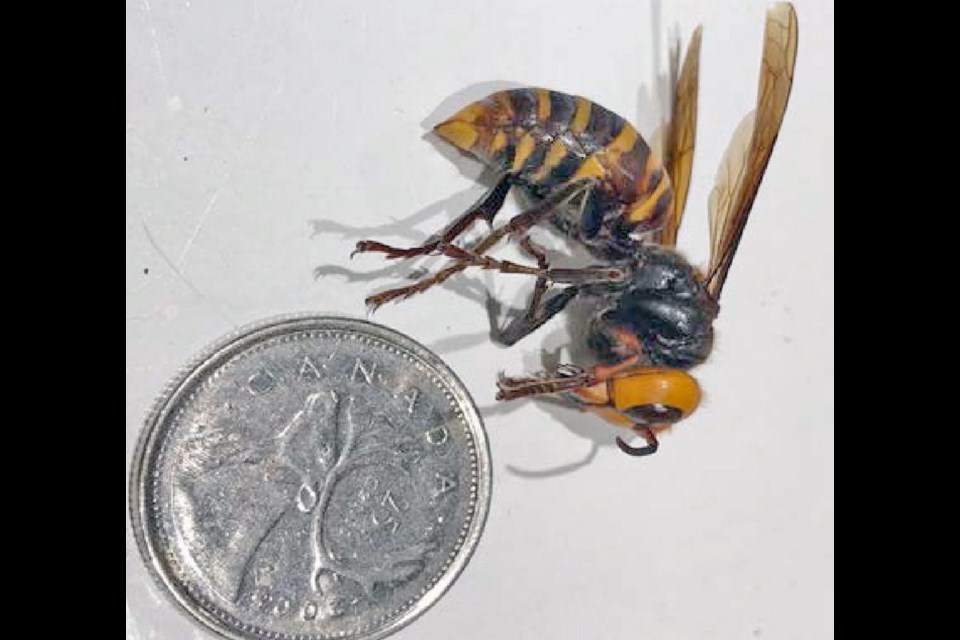A Saanich woman believes she spotted an Asian giant hornet — commonly referred to as the “murder hornet” — in her backyard over the weekend, but wasn’t able to kill or capture the insect for positive identification.
Heather Hanson was enjoying a beautiful day in her garden on Palmer Road when she noticed the big hornet buzzing around her flowers and lawn near her steps.
“I tried to step on it several times, but it seemed to see or sense me coming whenever I got anywhere near it,” Hanson said.
She’s convinced it’s the real deal.
“It was very big and the wing span was very large. It’s eyes were on top of its head — nothing like I’d ever seen before,” Hanson said. “I saw a picture of [the Asian giant hornet] the next day. I realized that’s what it was. I was amazed.”
Hanson said the hornet was about five centimetres long — “from the tip of my finger to the knuckle” — and the wingspan nearly as wide as her hand.
The Asian giant hornet (Vespa mandarinia), typically found in the forests and low mountains of eastern and southeast Asia, is considered invasive in B.C. Specimens and a nest were discovered near Nanaimo last August.
Since then, provincial apiculturist Paul van Westendorp said he’s been inundated with reports of sightings of the Asian giant hornet. So far, only a few of the hornets have been collected and no new nests have been discovered.
He said that some of the sightings may be “lookalike species,” including the bald faced hornet, horntail wasp, yellow jacket or elm sawfly.
But there have been confirmed sightings. An Asian giant hornet was found last November in White Rock and two specimens were found in December at Blaine, Washington. In May, an Asian giant hornet was identified and collected near Langley.
On Friday, Washington state announced it had captured an Asian giant hornet using a jar trap. It was taken on July 14 near Birth Bay, south of Blaine.
Recent credible sightings in the Cowichan Valley have prompted the deploying of at least four jar traps containing fruit juice and other lures at various locations, van Westendorp said.
The sightings were confirmed by local beekeepers and a forestry official, van Westendorp said.
The hope is to trap Asian giant hornets and eventually develop a grid system that will allow officials “to intensify trapping” and to narrow the search area for a possible nest.
A similar grid system of traps has been set up along the border between White Rock and Blaine, van Westendorp said.
“It’s like finding a needle in a haystack.”
Van Westendorp said there have been several calls about sightings, but almost all come in without photos or physical evidence. He urges people to take photos or collect a specimen, but to use extreme caution.
It remains unclear how the Asian giant hornet arrived in North America, but scientists say it was likely transported here in container ships.
The species present a dire risk to honeybee populations in British Columbia, and can destroy entire hives in a short period.
A bulletin from the provincial government says Asian hornets are not interested in humans, pets and large animals, adding they hunt insects for food.
The “murder hornet” moniker was coined in Japan, where there have been documented cases of multiple stings causing deaths.
Officials say disturbing a nest — built on or under the ground — will put the hornets on the attack. And a sting packs venom and a mighty wallop.
Entomologist Conrad Bérubé was stung seven times by the giant hornets last August when the first specimens and nest in B.C. was reported. The Nanaimo man told the Times Colonist two stings went through two pairs of pants he was wearing and drew blood.
He said the sting felt as though hot thumbtacks had been stuck into his leg. He experienced “throbbing muscular aches” in his legs for about 24 hours.
The Asian giant hornet has a “noticeably large” orange head and black eyes, according to a provincial government pest report.
Worker hornets are about 3.5 centimetres long, while queens can be as large as five centimetres. Wingspans range from four to seven centimetres.
If you think you have seen an Asian giant hornet, submit a photo of the insect to bcinvasives.ca/report, or send it directly to van Westendorp at [email protected]. B.C. residents can also call the B.C. Invasive Species Council at 1-888-933-3722.



